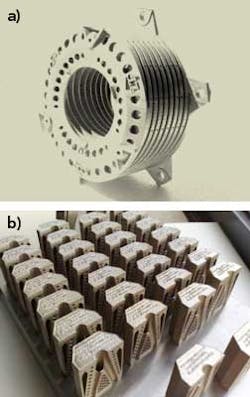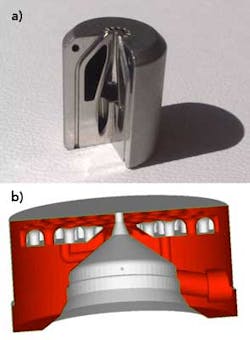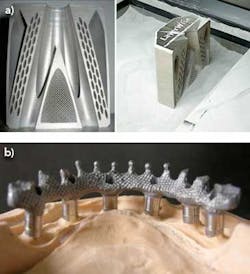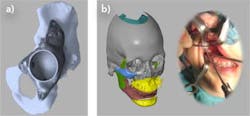Laser additive manufacturing gains new ground
Digital production of functional models in metal yields distinct product improvements and economic advantages
By Rob Snoeijs
LayerWise, Leuven, Belgium, is a company that focuses on selective laser melting (SLM), a powerful technology that shapes any desired metal part geometry by melting metal powder layer by layer. Using this digital approach, the optimum shape of complex circulation parts can be produced in a single manufacturing step. Such a part not only delivers better performance, but also is more reliable than the complicated assembly it replaces.
SLM technology is also the right choice for small metal products, thousands of which can be produced simultaneously. In addition to countless industrial applications, the company manufactures revolutionary orthopedic, maxillofacial, and dental implants. The core of the company concentrates on producing high-grade parts in any preferred metal alloy using less material and no scrap, reducing unit weight by up to 80%.
Limitations of metalworking processes
Metal cutting, milling, EDM, and other high-quality and efficient metalworking processes have a respectable track record on the production floor. Typical for these subtractive methods is that each in its own way is limited in removing part material, despite many tools and accessories.
Design engineers who know metalworking processes inside out take into account their specific limitations up-front. In a way, they design new parts, knowing at the back of their minds the production method that will be applied. It would be better if they could concentrate on the functionality of the part to be produced. The geometric limitations of successive metalworking processes force designers to make choices that devaluate the functionality of the part or lead to a complicated assembly instead.
Building up parts in layers
“At LayerWise, we reverse the entire process,” says Jonas Van Vaerenbergh, director of LayerWise's Industrial Division. “Our core business is selective laser melting, a technology developed to build up material in layers instead of removing it in different steps. In the meantime, we have optimized the process for a variety of metals and alloys, such as rust-proof steel, hardenable steel, titanium, aluminium, and inconel.”
In the machine, a high-precision laser is directed to metal powder particles in order to selectively build up a 20 to 40 micron horizontal metal layer. The metal powder particles pinpointed by the laser quickly and fully melt so that the new material properly attaches to the previous layer without glue or binder liquid.
The powerful fiber laser with high energy intensity operating in the inert area inside the machine guarantees that metal parts being built up exhibit a dense and homogenous material structure. CAD directly drives the machine without requiring any programming, clamping, or tooling. The SLM approach is capable of simultaneously producing metal parts of different shapes in series of up to 2500 pieces. As this impacts economics favorably, LayerWise can offer favorable unit prices and short delivery times.
Unlimited freedom of shape
In addition to producing small components efficiently and cost-effectively, SLM does not impose many limitations in terms of geometry. Van Vaerenbergh explains that the layered approach ensures that the laser gains systematic access to any location while building up parts. In this way, the most complex part shapes can be produced, including recess, ribs, cavities and internal features.
“Usually, the products leaving our facility cannot be produced any other way. This is a different ball game for manufacturers because design rules are packed in, removing all obstacles in favor of extreme part optimization," adds Van Vaerenbergh.
Take the burner component LayerWise produced for Diametal, a Belgium contract manufacturing company processing metal parts on CNC milling and turning machines. Similar to machine manufacturers for food and pharmaceutical companies, Diametal is regularly challenged with producing complex circulation pieces such as mixers, inlet and outlet components, dispensers, coupling parts, and heat exchangers.
The Diametal burner component contains nine undercuttings and six internal cavities. LayerWise applied SLM to manufacture this component as one unit in a single production step. This process is called function integration because this SLM-produced component replaces multiple parts manufactured using conventional metalworking processes. Assembling these parts takes time, particularly because they need to be connected hermetically, reducing reliability altogether.
Van Vaerenbergh explains that function integration makes SLM fit for resolving miniaturization, leakage, and assembly issues. “Diametal was not charged for the shape complexity of the part because the production cost is dependent on the weight of the part, showing that SLM offers superior products at a reasonable cost.”
Optimizing circulation channels
A perfect example of efficient and flexible design was the production of a component that connects cooling ducts. First, the additive manufacturing process realized 75% weight reduction. Second, designers were able to drastically reduce flow resistance by defining channel geometry using freeform surfaces. LayerWise produced the part exactly according to the functional CAD design, resulting in an improvement of the circulation properties by 80%.
According to Van Vaerenbergh, the manufacture of injection mould inserts also yields impressive results. “Thanks to SLM’s freedom of shape, the cooling channels can be positioned in conformity with the mould shape. This is a major improvement compared to conventionally drilled holes. Optimized channel geometry and location ensure a better controlled cooling process that delivers higher-quality parts that do not warp and contain fewer hot spots. Imagine the economic advantage of reducing the serial production cycle time of moulded plastic parts by 15%.”
Focus on technology leadership
LayerWise is the first production center in Belgium that exclusively focuses on this additive production process for metal parts. The company was founded by Jonas Van Vaerenbergh and Peter Mercelis, both of whom were closely involved in the development of selective laser melting at the Katholic University of Leuven. LayerWise collaborates intensively with the university, and systematically invests 30% of its resources in research and development to push the boundaries of the technology.
“By bringing together technological expertise, production capacity, and customer support, LayerWise occupies an unique position on a European level,” says Van Vaerenbergh. “Our engineers control SLM to such an extent that they are capable of perfecting the technology and realizing the most challenging specifications. Today we are able to produce with 15 micron geometric accuracy and build up walls as thin as 0.2 millimeters, something that is extremely difficult – if not impossible – using conventional technologies. Also, the implementation of process control tools in and around the melting zone is important to guarantee highest part quality.”
By acquiring full control over the production process, LayerWise achieves a homogeneous micro structure with a relative density of up to 99.98% for an increasing number of metals and alloys. Research shows that the mechanical properties are virtually the same as those of conventional metals. To prove this, LayerWise systematically carries out mechanical tests on the level of density, hardness, elongation, and fatigue. In advance, the chemical composition of the bulk metal powders are examined in a chemical laboratory.
Production machines run unattended
The machinery of LayerWise consists of top-quality systems that run around the clock. Quickly producing prototypes is possible, but this activity is usually a leg up to serial production. As CAD files are directly converted into three-dimensional geometry, SLM is a cost-effective metalworking process that allows for unattended production.
After parts are taken out of the production machines, finishing actions start. If desired, conventional metalworking actions can be applied, such as drilling, cutting, and EDM. It is also possible to harden surfaces of certain components. As a concluding step, customers can opt for a high-gloss polishing finish.
Dental suprastructures
LayerWise is also heavily involved in medical industries, for which the company manufactures implant-supported suprastructures, for example. On the basis of patient-specific geometry data, acquired through medical imaging or three-dimensional scanning, the personalized structure is designed in software and printed in titanium right away. As a final step, the dental technician finishes off the structure and completes the final prothesis.
“Through digital SLM technology, geometry and surface retention related limitations set by traditionally moulded or milled suprastructures no longer apply,” says Peter Mercelis, Director of the Medical Division. “In addition, the implant connections are completed with highest precision.”
DentWise suprastructures are manufactured using ultra strong titanium alloy (Ti6Al4V, grade V), which outperforms the commonly used titanium grade II in terms of mechanical properties.
Orthopedic and maxillofacial implants
LayerWise specializes in other medical applications as well. During a major maxillofacial reconstruction, sugeons inserted a zygoma manufactured by LayerWise. The complex shape of the implant was digitally derived through medical imaging and produced using SLM technology. This approach can restore the facial symmetry of patients nearly perfectly.
Concerning orthopedic implants, the process of building up metal in layers offers the possibility to design porous bone-replacing structures and integrate them into protheses. This allows for an excellent long-term fixation. In addition to personalized implants, designed on the basis of medical imaging, the SLM technology is used for manufacturing medical instrumentation. For this purpose, LayerWise offers a number of biocompatible metal alloys.
Growing along with the technology
Two years after its inception, LayerWise has grown considerably. Recently, the company appointed a number of European distributors, a part of a strategy to gradually operate on an international scale. “After propagating the SLM technology and its advantages to different industries, companies realize that they can truly benefit from the technology,” concludes Van Vaerenbergh. “Additive metalworking processes change design and production rules completely. By realizing projects together with customers, we offer companies plenty of opportunity to create more added value and produce more cost effectively.”
______
Rob Snoeijs holds an engineering degree and works as a technical/editorial writer for several European-based technology firms. For more than 20 years, he has written about the edge of new innovative technologies and the way they influence design and manufacturing. Contact Rob at [email protected].




